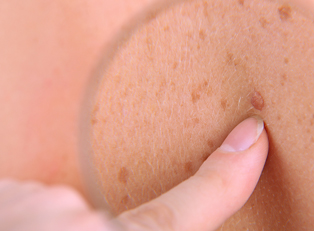What causes Skin Cancer?
Skin cancer is the most common form of cancer in the United States. It is also one of the few types of cancer that affects similar subsets of the population regardless of age, gender, or race. There are three different types of skin cancer: basal cell carcinoma, squamous-cell carcinoma, and perhaps the most widely-known type, melanoma. The first two types are, by far, the most common forms of skin cancer. These two forms, while serious, do not typically spread. The third form, melanoma, is infamous because of its tendency to spread cancer throughout other areas of the body.
Most skin cancer is caused by harmful overexposure to sunlight. Individuals who frequent tanning booths or regularly use sunlamps are also at risk for developing skin cancer. When tanning, whether by direct sunlight or in a tanning booth, skin is exposed to ultraviolet radiation. This radiation causes damage to the DNA of skin cells which can lead to the development of tumors. For this reason, sun burns can put you at risk for skin cancer. Skin cancer can develop on any part of the body including face, scalp, arms, and legs. While these specific areas are usually exposed to sunlight, skin cancer can also affect other areas of the body that are not typically exposed to sunlight. It is important to wear sunscreen with an SPF of no lower than 15. Make sure the sunscreen contains both UVA and UVB protection. Apply sunscreen at least 15 minutes before going outdoors. Even on cloudy days when the sun is not directly visible, ultraviolet rays can reach the earth’s surface. Clouds may even make UV prevalence worse by redirecting reflected rays back down towards the ground. Wearing a hat and long sleeve clothing can also help protect skin.
Individuals may be at a greater risk for developing skin cancer if there is a family history of cancer. People who have fair skin are also at risk. If there are any changes on the skin, it is important to talk to your doctor, especially for moles or freckles that have recently started to change color or shape. Not all moles are cancerous and not all changes in moles are cancerous. However, it is best to notify your doctor of any new moles forming, particularly if there is a family history of skin cancer. An abnormal looking mole can turn into melanoma over time; therefore, it should be checked right away.
Other causes of skin cancer not related to the sun include chronic tobacco use. HPV infections also increase the chances of developing skin cancer, specifically squamous-cell carcinoma. Environmental carcinogens are believed to play a role in the development of certain skin cancers. Arsenic and petroleum by-products, for example, are known to increase the chances of developing squamous-cell carcinoma. Work environments with increased exposure to radiation may also lead to the development of skin cancers. Individuals who weakened immune systems or deficiencies are at a particularly high risk for developing skin cancers due to their inability to fight infection. Close care and monitoring should be taken in these cases as these persons are more likely to have cancer spread to other parts of their body.



